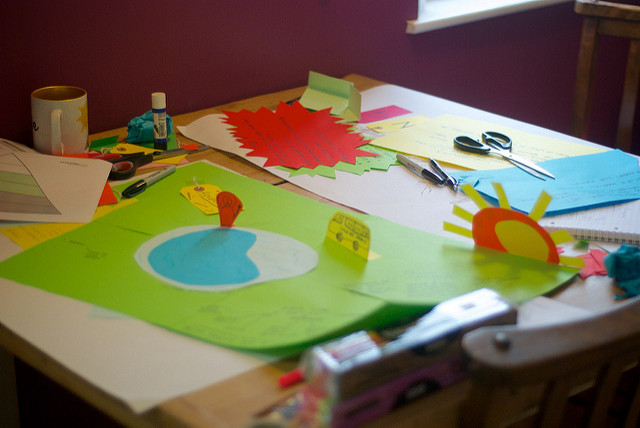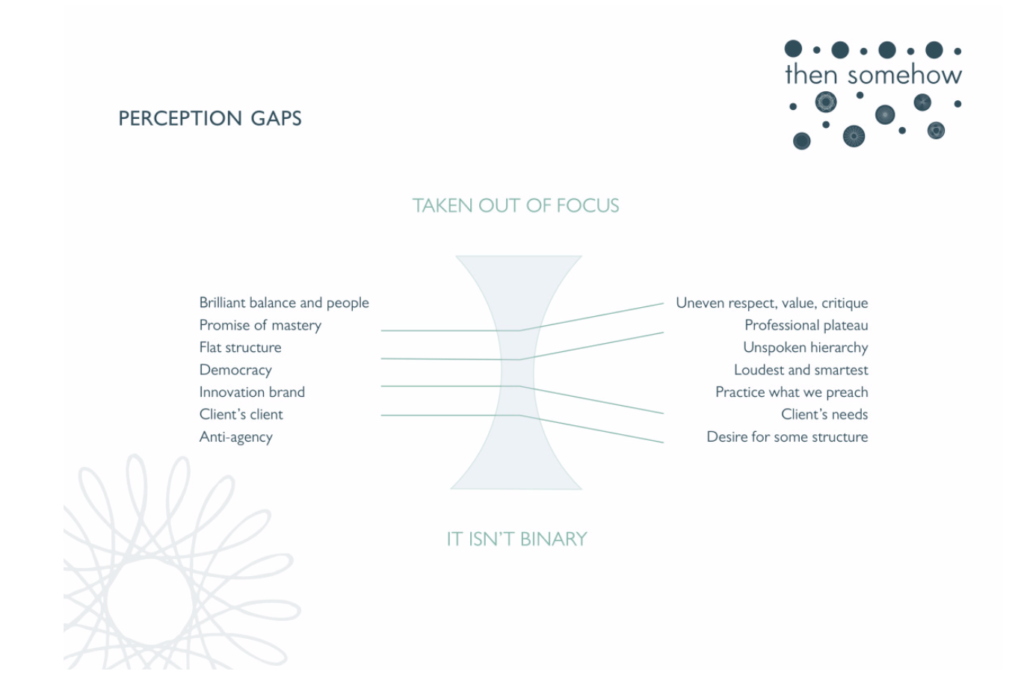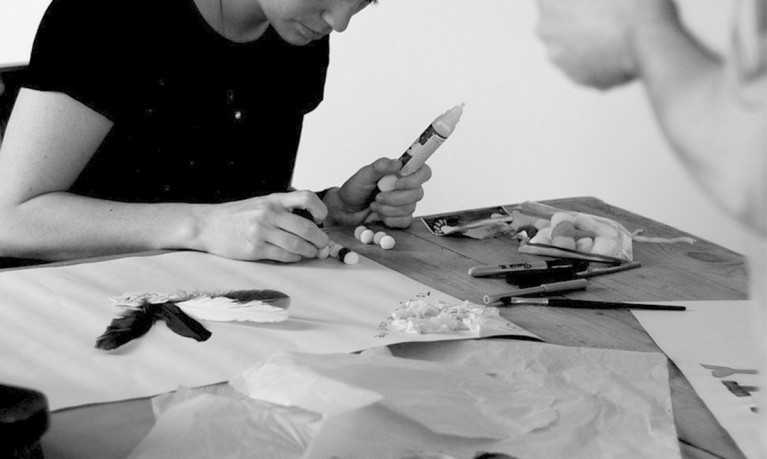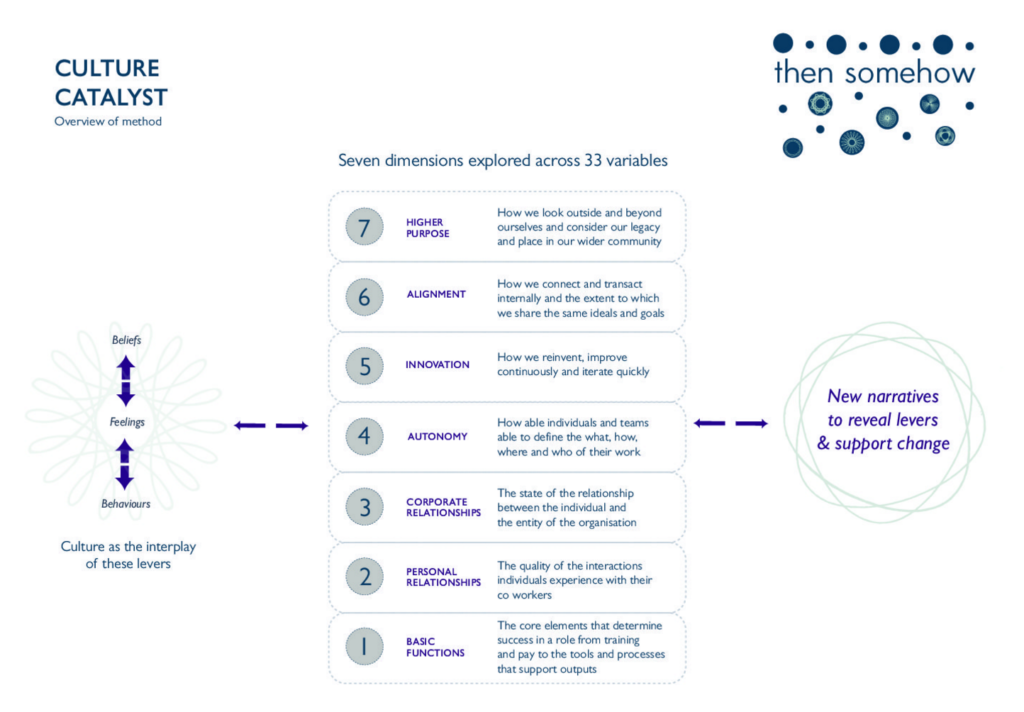by Steven Rabson Stark
It is widely accepted that in changing times, all organisations have to change themselves to keep apace.
What is less well understood is how leaders can ensure that when change is required, it happens easily, is adopted by all concerned, and has success.
We’ve all been there – your organisation needs to take on a new contract; there is a direct competitor and you need to differentiate; you’ve merged or you are taking on a new team.
What do you do? You enter strategy development mode of course.
At Then Somehow… we’ve all run companies as founders, managing directors or senior mangers. We’ve worked in media, research and design. We’ve worked for big companies and small companies and importantly we have all experienced the highs and the lows, the pressures and the pleasures of work.
What we have all observed is that leaders love a strategy. Love a big idea and love creating a plan for how they might deliver it.
The less love-able bit, the process of ensuring the strategy will have buy-in, will be understood, adopted by everyone in the organisation and guaranteed to be deliver is too often neglected. That’s the messy bit.
That is the bit that we love.
Making strategy land
How do you ensure a strategy is not just a piece of paper? If they think of doing so at all, leaders rely all too readily on the operating system of their organisation for success, how the HR or finance systems are run, what the cash flow and budgets look like, tinkering around the edges. Their problem is that they are looking at the wrong operating system.
The operating system they should be looking at is the one that shapes and defines every input and output the organisation touches — company culture. That culture is the sum of what we feel, believe, and do in our organisation.
Only by understanding that culturecan you consciously shape the direction of your organisation, write a strategy that will work, that will enact the change you need. When you know where you’re starting from, you know where you can go next.
The muddle of metrics
The stock response to the need to understand where we are at is the employee survey. Leaders get the idea that they need to hear what people are experiencing as part of making a change. They want a benchmark, evidence that what they do next has worked when they measure again.
So out goes the survey with 50 or more questions in various shades. And back comes metrics: black and white, hard reassuring proof. This is where we are. This is what people experience. Then when we tinker with process and systems and we measure again, we can see how far we have moved. Evidence of success.
But do the metrics really tell us anything useful? Lot’s of charts over lots of pages, often showing the same data cut in various ways. (Why are these reports so ugly?) But does it tell us what to do? Does it tell us why? Does it tell us how?
How often are we beguiled by a nice round score? Like the client-who-shall-remain-nameless, who was pleased that 80 percent of their staff agreed with the statement “I have not experienced bullying at work.” That’s a great score, no problem here. Except that in an organisation of 400 people 80 did not agree with that statement. 80 people may be feeling bullied.
Metrics can camouflage the real issues. They also impose a framework of value that is not always helpful. Once we measure a thing we want, our scores go up. There may be unintended consequences of pursuing a rising number. What else gets overlooked? What other things that aren’t being measured get distorted? We want to compare ourselves to others. But who’s to say that what is right for one organisation is right for another? The form of a fox is of no better or worse than that of a bat. Actually what matters is what is right for this specific context, cold numbers may not be helpful here.
Then there are the questions that you can’t answer. Happy Melly’s Jurgen Appelo in a podcast with Ricardo Semler (10mins in) acknowledged: ‘Frankly I have no idea how to measure happiness.’
That may be an issue for an organisation that seeks to increase happiness at work. Happiness and culture are intangible things: will-o’-the-wisp. So how as leaders can we usefully measure, identify and evidence it – so we might be able to shape and improve it? How do we make the invisible visible?
A catalyst for culture change

That’s the kind of problem we enjoy at Then Somehow… after all, we make tools for the messy stuff, so we developed a tool we called Culture Catalyst.
It has been designed by us — leaders and owners of organisations — to help people like us. People who want to learn what is happening within their culture, so they can implement a strategy that they know will work, so they can test and iterate their efforts to effect change.
We believe that if you can understand your company culture you can:
- talk about what needs to change
- focus your attention
- benchmark and measure progress
- design strategy you know will work
If you can’t talk about your culture, your context, you can’t act with intention and can only respond in a reflexive or conditioned way.
Metrics don’t capture culture. Stories do.
Culture Catalyst maps your organisation’s strengths and weaknesses, not from the traditional lenses of profit and loss, but through the beliefs, feelings and behaviours your people experience and the symbols and stories they share.
But we do have metrics. You have to have metrics. Without metrics you free yourself too much from the conversation. Organisations need to measure. Leaders need to understand and metrics do give value. So we use a combination of data and stories. These are blended together to form a single narrative, helping make your culture visible, tangible, measurable and changeable.
This narrative consists of two parts:
- A digital quantitative survey, customised and normative.
- Qualitative listening activities, informed by the quantitative data.
We measure and map against seven dimensions of culture culture, which are:
- basic functions
- autonomy
- personal relationships
- corporate relationships
- innovation
- alignment
- higher purpose
You can read an example of these seven different variables here. But each programme is bespoke and there are always other components keyed in so we can look specifically at particular areas of interest.
We run the survey, whenever possible, with everybody at once at a big kick-off meeting, a ceremonial start of the process. We want people to sense that this might be going in a different direction.
The metrics from the survey provide clues as to where we should be looking. The questions we should really be asking and the way we should ask them.
Importantly we make the way we capture the stories play an important role in the project. It’s different every time. We sometimes build story maps in small groups, letting coworkers extract each other’s stories, sort them on a wall, draw their own conclusions, articulate their own summary and meaning. We watch how they do it, note resistance, enthusiasm, observe interactions. Scribble notes furiously about the stories of the stories. Paints come out, things are drawn, models get made. Stories are shared and captured.
It can be transformative for teams since it is inclusive, collaborative, engaging. It’s an opportunity to try out different ways to engage with your people, to extend their own box of tools. It creates an end product that has shared ownership across all levels.
Then we sort them, filter them, weave them with the metrics to create a coherent narrative, a map of the culture that the organisation will recognise and understand. We share it with leaders first, and then everyone in your organisation.
The ‘map’ explains how people feel, why they feel that way, and suggests likely pathways for making it better. It’s useful. It’s frank. It’s in their own words. It sometimes needs to be handled with care.
It also looks great.

A Culture Catalyst Case Study
So who has used it and what effect have they seen?

Propellernet are a search marketing agency, regularly judged to be one of Europe’s best places to work. They are interested in continuous improvement and finding that ‘extra ten percent’ that helps fulfil their purpose of ‘making life better’.
The whole company of 50 people took part in the Culture Catalyst programme including the leadership, team members, and a new product division. Everyone completed a customised online survey and had follow up one-to-one interviews. Those conversations ranged wide and far, delving into individual background, aspirations for the future, life as it is now. We went on to produce posters that represented individuals’ experience and expectations of being there. It was messy, fun and the posters stayed around for weeks: a symbol of the intention behind the programme.
We were able to share a narrative that revealed, among many things, the different experience of work at various levels in the organisation. Understanding that helped managers find ways to adapt their behaviours, reset their assumptions and ultimately reduce that experience gap. Importantly it helped the leadership team understand that even in the most happy of companies, there actually was room for improvement. And that was OK because we were also able to identify things they could do to become even better.
It was absolutely brilliant. It showed us where to focus, helping us understand our strengths and the weaknesses that we were failing to address. It inspired us to act, engaging with our culture and actively trying to shape it. We didn’t know what we’d been missing and in hindsight that was risky. We’re a lot better informed now.
Nikki Gatenby, MD, Propellernet

With another client, Culture Catalyst revealed a frustration with what was perceived as unfair pay. This was a real surprise. The client immediately ran a salary benchmarking exercise and shared the results. In fact, pay was slightly above average for the locality and sector. The Culture Catalyst revealed and helped the client dispel this false and corrosive belief, and also uncovered the underlying issue: confusion around what people should expect to give and receive through their work. Addressing this deeper social contract helped release more enthusiasm, motivation and commitment across the organisation.
We love a happy ending.
Future tools and playing together
We are really happy with the Culture Catalyst tool. It’s helping leadership teams have the conversations they really need to have. It’s helping them develop strategies that have a better chance of working. It’s helping them give ownership of change to their people. We are now using it in a range of contexts.
It’s not always easy to sell in though. Some of us are wary of stories, fearing what they may reveal. They are not as safe or predictable as numbers, they do need handling with care. Inevitably it’s the leaders who need to develop their skills and take responsibility for their, often unconscious, impact on the organisation. So we’ve started to play with a ‘lite’ version of the tool that eases you in gently.
It’s mainly metrics, it allows people to benchmark themselves. It could make some of the mistakes other surveys do. What we intend though is that it start a conversation about how much scope there is for your organisation to be better at being what it uniquely is. The best version of itself.
We want to hook people in to that idea. Start a personal enquiry. Good company culture looks different in different places. There is no right way, no formula for success. If you are going to shape your culture, your operating system, it starts with understanding your people better. You and your people make the culture though your beliefs, feelings, behaviours, through your narratives, through your symbols and through the shape of your systems and processes. You and your people need to be engaged with it, involved in articulating it, involved in shaping it.
It starts with the right questions, asked in the right way.
If you’re interested in this sort of challenge, there is more at our website. We’d love to play together.
Photo credits: Al Reid @bigredal


